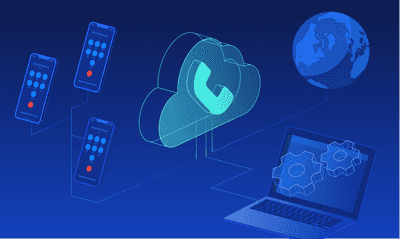How to Strengthen Your Inbound Calling Strategy
In this blog post, you will learn how to set up your inbound calling center, optimize your inbound call strategy, and in doing so, how to improve customer service and satisfaction.
9 min read

Christopher Rees
Mar 16, 2021

A good inbound calling strategy can be the difference between a happy and an unhappy customer and should therefore not be underestimated. Your inbound calling strategy can affect everything from how quickly the team picks up the phone to how they resolve your customers’ issues or how they deal with customer complaints.
When a customer has a query, they want immediate assistance. It is your business’s responsibility to make sure that there are the necessary channels in place for your customers to contact you and that when they do, there is a strategy in place to find an effective resolution. While there are a number of channels that a company can use to provide customer services, such as email, chatbots, or social media, a phone call is still one of the most popular tools that customers use to resolve their issues with a company. With phone calls resulting in greater customer satisfaction, investing in your inbound calling strategy can bring significant value to your company.
While having a solid strategy to handle your customers’ queries and complaints is incredibly valuable, knowing where to start can be no easy task. In this article, we will talk about the difference between inbound and outbound calls, look at the benefits that an inbound call center can have on your company, and then help you devise a strategy to make sure that your inbound call center provides the best service possible to your customers.
What Is Inbound Call
Just as the name implies, an inbound call is an incoming call from a customer to a company. Typically an inbound call is made by an existing or potential customer when seeking some form of customer service.
While the type of customer service can vary, the typical inbound call strategy is focused on answering questions, resolving customer queries or complaints, taking payment, or setting up a service. Since an inbound call is often the first point of contact for your business, they must be dealt with in a professional manner, with your representatives being polite, knowledgeable, and helpful.
Inbound calls are handled by an inbound call center or company help desk, and depending on both the volume of calls and the company’s size, companies may choose to outsource inbound calls or offer a 24/7 service.
Inbound Vs. Outbound Calls
Inbound and Outbound calls play a vital role in interacting with your customers, and while both types of calls focus heavily on customer service and client satisfaction, they have different roles in your business’s success. Understanding the difference between inbound and outbound calls will help you find the right solution for your business’s needs.
The main difference between inbound and outbound calls is how the call takes place. An inbound call center receives incoming calls from customers, and as they are often customer service-based, the calls mostly come from existing or potential customers requiring support with issues to answer questions.
Outbound calls are where the representative will make the call to the customer. Often run by sales teams, outbound calls are geared towards customer success. Outbound calls are also referred to lead generation, where the representatives make outgoing, cold calls designed to gather interest and sell a product or service to potential customers. While typically sales are the most common reason for outbound calls, some companies use outbound calls to conduct market research, gathering data and insights through questionnaires.
However, we are beginning to see companies offer a hybrid between inbound and outbound calls as an alternative solution for their customer support strategy. Rather than require the customer to wait on hold, customers are able to fill out a form and request that a customer service representative calls them to solve their problem. This is more time-efficient for the customer, but it also gives the sales representative time to investigate the client’s profile and prepare a potential solution.
Inbound Call Center Services
Taking calls to provide customer service is the most well-known and common function of an inbound call center. However, in saying that, customer service types can vary between companies, with some offering one service and others providing a multi-solution approach. Here are some of the most common inbound call services that an inbound call center will provide.
Tech And Product Support
Technical support is for customers who have an issue with their service or product. If they find that their product or service is not functioning properly, customers will often call an inbound call center to speak to an expert to resolve this issue. The type of technical support that the representative will give can vary from troubleshooting to password resets to basic guidance. Technical support representatives are often trained IT professionals; their expertise means that they are able to quickly and efficiently solve your customers’ problems.
Customer Service
Customer service is often the first point of contact for your company, and they are often able to handle a range of queries that your customers may have. This can involve everything from general customer queries, product returns, updating account information, booking appointments, or billing and contract queries. Customer service representatives are multi-skilled professionals who can assist with a range of inquiries and are well-versed in company policy.
Complaints
While all of the inbound call representatives should be able to deal with complaints, for certain businesses, they have special procedures or teams to handle complaints. To ensure customer satisfaction and help to retain customers, the complaint team will often have additional powers where they are able to offer discounts, refunds, or other incentives to resolve the problem amicably.
Inbound Sales
While most shoppers turn to online or in-store solutions, some companies also provide sales over the phone. Along with selling products, the inbound sales representatives will be trained in everything from upgrading or downgrading plans, renewing contracts and subscriptions, and resolving any billing issues.
How To Set Up Inbound Call Center
As the first point of contact, call centers are an integral part of building customer experience. Inbound call centers should be client-centric, meaning they are a lot more complicated than simply answering the phone, responsible for nurturing relationships; your call center needs to maintain a high level of customer service at all times. There are a number of important steps that go into building an inbound call center; following these will teach you how to setup inbound call center creating the optimal call center for your business.
Define Your Call Centers Core Purpose
The most important step in setting up an inbound call center is defining your call center’s core purpose. Your call center’s objectives should be unique to your business and focus on what your company’s goals are, as well as what kind of services customers need, whether it be technical support, customer service, inbound sales, or a combination of the three.
Determine The Volume Of Calls
The volume of an inbound call center can vary significantly depending on the size of the business, the service they provide, and the industry they are in. Some inbound call centers experience large quantities of phone calls; the larger the volume of calls, the more sales representatives you will need. To get an idea of how many agents you will need and how many calls they will be taking, you will need to look at your usage reports and speak to customers to find out how often they will need your support.
Get The Right Equipment
Once you know what your call center’s purpose will be and how many staff you will need, you can start to look for the right equipment for the job. For an inbound call center, you will need a few different types of equipment, such as:
- Call Processing Software: This is to process calls and link them from customer to sales representatives.
- CRM: This is to manage your client’s details and improve customer service.
- Calling Tools: Can help you to track and monitor calls for quality control.
- Hardware: Headsets, computers, monitors, and keyboards for the sales representative to effectively do their jobs.
Inbound Call Strategy
Now that you have got all the tools to set up your inbound call center, you can work on your inbound call strategy to optimize your team and ensure that your customers are satisfied.
Define and Analyze Your Inbound Call Center Metrics
A solid inbound call center strategy will center around your KPIs. The KPIs for every call center will vary depending on your target audience and their needs. The most important KPIs for a call center will include call volume, average talk time, time to resolution, time in queue, and abandon rate; these are essential for letting you know if your call center is providing adequate support. These core KPIs will directly impact other KPIs that are important for company growth, such as customer churn rate and overall client satisfaction. It has been shown that most customer dissatisfaction can be solved in that first initial contact, so ensuring that your KPIs are properly defined, and you regularly conduct an inbound call analysis will play a key role in the success of your inbound call strategy.
Invest In Your Team
Customer service often gets dismissed as an easy job, but anyone who has worked in customer service knows that this is simply not the case. Not only do your inbound call center representatives need to relay vast amounts of information, but every customer has specific needs, and your team needs to be cross-trained and multi-skilled to cater to their needs.
Customer service representatives need to have clear communication, great problem-solving skills, and be able to deliver solutions that will fit the customers’ unique needs. Consistent training and support for your team will give them the tools to excel at their jobs while making them feel valued and supported.
Use Data To Your Advantage
A good inbound call strategy enables your company to provide an exceptional service to its customers; incorporating the use of customer data into your strategy will only improve this. Every time your representative takes a call, information can be recorded in a CRM; this data enables you to better understand your client, their problems, and their needs. CRMs are an invaluable tool as they allow your representatives to quickly and easily access your customers’ data allowing them to have a more seamless and personalized interaction, resulting in overall better client satisfaction.
Promote Your Call Center
Along with being able to solve your customers’ queries, your inbound call strategy should also include making customers aware of its capability. Promoting your call center’s capability and the services that it offers makes your customers feel informed, engaged, and supported. When onboarding new customers, your inbound call strategy should be aligned with your marketing and sales strategy, demonstrating that along with your product, there is excellent customer service on the other side of the phone.
Conclusion
The way that you respond to your customers or prospects when they call you can make or break the relationship. Inbound call strategies are designed to help you ensure that your team develops an effective approach to customer service, making sure that customers are taken care of. Devising and implementing a solid personalized inbound call strategy will not only ensure that your customers are satisfied and help promote growth by setting you apart from your competitors.


